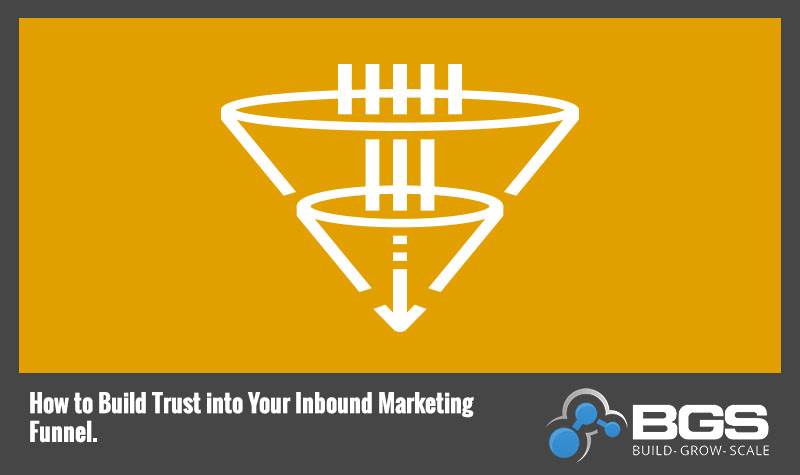How to Build Trust into Your Inbound Marketing Funnel

Inbound marketing is a handy way to stretch an advertising budget. This marketing strategy gives your company a voice, which increases brand awareness. The key ingredient here is trust. Following is a short top-down view of the inbound marketing process:
- Starting out – You have little non-promotional content on your domain. To fix this, you create a blog that’s centered on your industry, your brand and your product or service. Creating content that engages visitors and gives them the information they need is a top priority. You promote your blog to sites such as Reddit, StumbleUpon, Scoop It! and Inbound.
- Gaining traction – You continue to engage readers with quality content and to promote your content. Build your audience with forms and calls-to-action. Offer a useful freebie such as an eBook or access to an exclusive webinar in exchange for an email. Make sure that your company website has a strong landing page that features testimonials or other forms of social proof.
- Managing leads – At this stage, you’re engaging leads via CRM, retargeting campaigns and email. Don’t hit your leads over the head with marketing, though. Keep your focus on publishing quality content and the leads will flow organically. Build relationships through email marketing. Focus on the long-term viability of your list.
- Nurturing the customer base – Create sharper customer personas by sending surveys to your existing customers. Find out what anxieties caused your customers to delay the purchase. Next, create content you know will appeal to your growing customer base. This smart content will help you recruit brand ambassadors. Finally, build on the buzz you’re receiving with social monitoring.
This process isn’t linear. At any point in time, your visitors will be in various phases. The phases of inbound marketing are:
- Attract
- Convert
- Close
- Delight
Focus on the final phase to make sure you’re building the relationship even after the sale. Again, smart content is a stellar way to keep customers engaged.
Building Trust with Quality Content
Inbound marketing requires high-quality content. Your content should:
- Be free of typos and grammatical errors – When prospects see typos on your blog, they will make assumptions about your product. This isn’t fair, but it happens all the time. Confusing “to” for “too” or “effect” for “affect” once is enough to create a bad first impression.
- Back up its claims – You should research your posts in-depth. Your visitors will appreciate the extra effort, and this goes a long way to building trust. Use a PDF search engine (link) or Google Scholar to cut through the fluff. Cite any sites or research papers you used to create your post.
- Add to the conversation – Don’t create carbon copies of what’s out there. Every post you publish should bring something unique to the table. If you aren’t an expert in the topic you’re covering, tap into your LinkedIn network. Securing interviews is easy to do if you have a popular blog and can offer a link back.
Infographics are inbound marketing rocket fuel. These handy graphics can be pricey to produce, but if you have a mature social media platform, they can go viral. Always place your URL at the bottom of the infographic, but avoid watermarks. They are unnecessary and most consumers find them obnoxious.
Pleasing the Gatekeepers
Too many marketers think of inbound marketing as a magical funnel that turns visitors into paying customers overnight. That’s not how it works. It’s about building relationships. You will get results when social media influencers champion your content.
Once you have advocates, you’ll notice far more readers going from stranger to customer. Your email list will explode, as will social shares. Here is how to approach influencers:
1. Avoid the shotgun approach.
Don’t approach just anyone. Take the time to find social media influencers who are taken with your site. You can use Buzzsumo and Mention to find these people quickly. Look at their social media profiles and Klout scores. Then cherry pick prospects for outreach. Sending the same email to a bunch of influencers won’t get you anywhere.
2. Build the relationship.
Don’t barge into an influencer’s space asking them to promote your content. Build trust by sharing their content first. You could also @mention them with content you think they’ll like so long as the content doesn’t live on your domain. This outreach takes time, but it will pay off.
3. Get to the point.
When you make a pitch, be clear about what you want. Some influencers aren’t comfortable tweeting or posting about products so don’t get hung up on getting a testimonial. A tweet from someone with thousands of targeted followers is still a stellar result.
When you build trust with your audience, the buying process becomes a no-brainer. Don’t worry about when a prospect will convert. Instead, direct your energy toward building your inbound marketing platform with integrity and efficiency. If you have any questions drop them in the comments below or you can check out some of our other resources.






